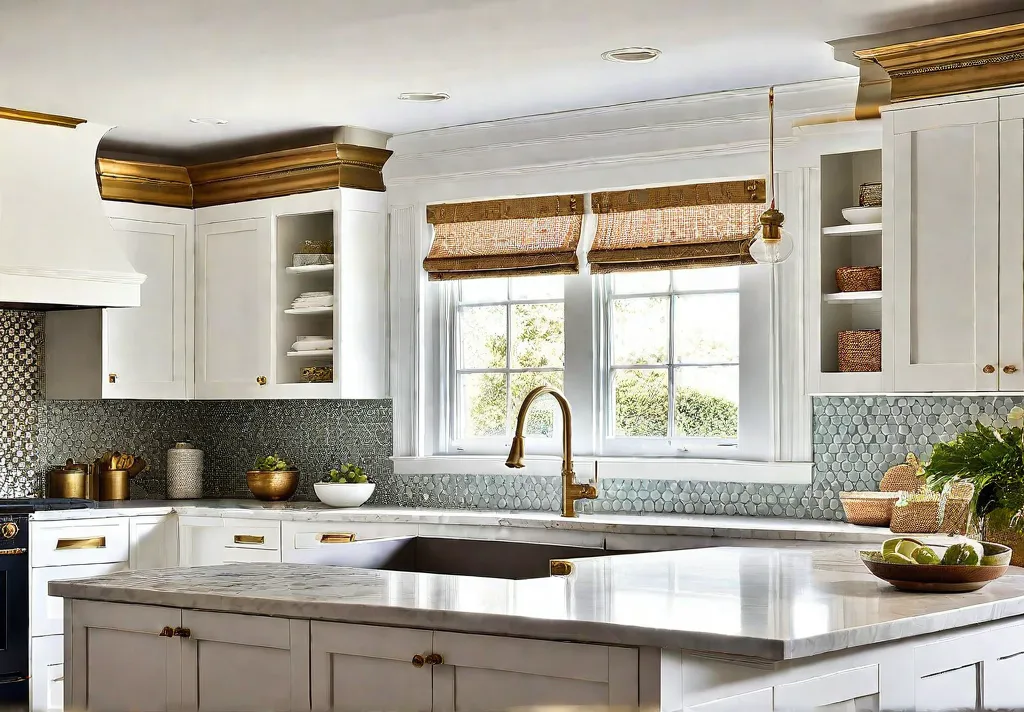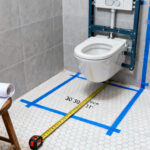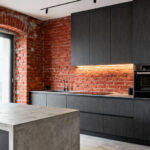The details truly matter when creating a kitchen that exudes timeless charm and sophistication. As a passionate advocate for intentional design, I believe every element should be carefully curated to elevate the overall aesthetic and functionality of the space. From the graceful curves of crown molding to the eye-catching patterns of decorative backsplashes, each feature plays a vital role in crafting a kitchen that feels like a work of art.
In exploring traditional kitchen elements, we’ll delve into the world of crown molding, uncovering how this architectural embellishment can define a room’s character. We’ll also discover the transformative power of decorative backsplashes, turning functional surfaces into stunning focal points. And for those seeking to infuse their space with a sense of history, we’ll uncover the allure of antique hardware and vintage appliances, blending timeless charm with modern convenience.
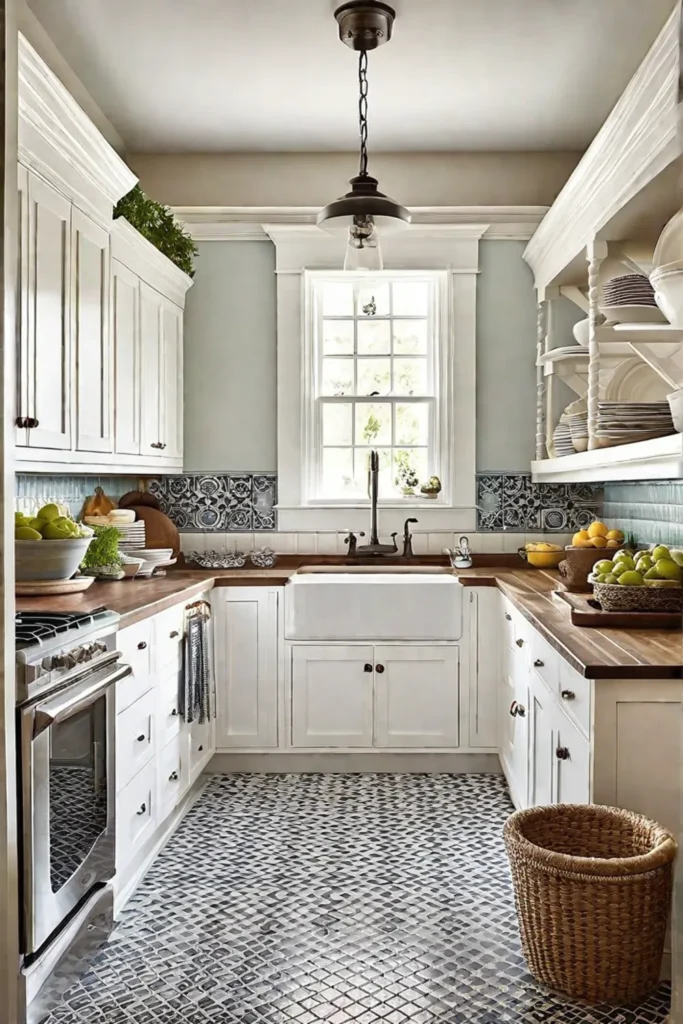
However, the true essence of a remarkable kitchen lies not just in the individual components but in the harmonious interplay between them. The delicate balance of form and function, the seamless integration of old and new, creates a space that feels authentically inviting and deeply personal. So join me on this journey, where we’ll uncover the secrets to curating a kitchen that transcends mere aesthetics, reflects your unique style, and celebrates the art of living well.
Enhancing with Crown Molding
I firmly believe crown molding is essential in creating a traditional and sophisticated kitchen. It adds a touch of architectural interest and elegance, gracefully defining the transition between walls and ceiling.
Choosing the Right Style
Crown molding comes in various styles, from ornate and intricately carved to sleek and minimalist. When selecting the perfect style for your kitchen, consider the overall aesthetic you’re aiming for. Intricate, decorative moldings pair beautifully with traditional cabinetry for a classic look, while simpler profiles complement shaker-style cabinets and more contemporary designs.
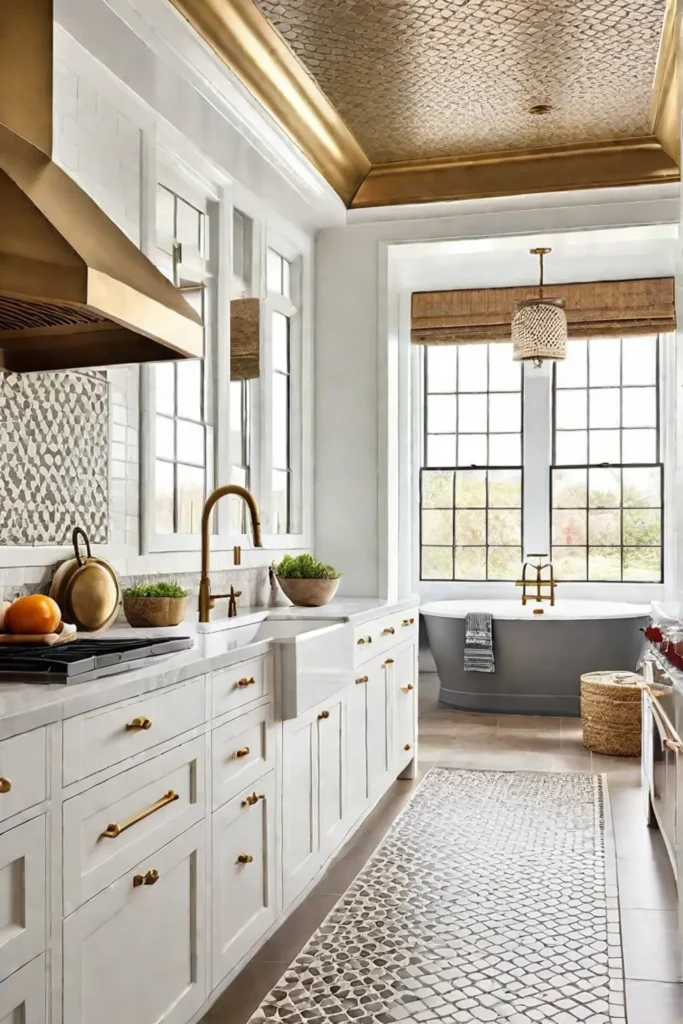
Installation Tips
While crown molding installation may seem daunting, with the right tools and techniques, it’s a project that even DIY enthusiasts can tackle. When choosing the appropriate size and style of molding, pay close attention to the ceiling height and room size. Proper measurement and cutting are key to achieving a seamless, professional-looking finish.
Crown molding has been used for centuries in architecture, dating back to ancient Greece and Rome. The style you choose can significantly impact the overall feel of your kitchen, from ornate and traditional to simple and modern.
Crown molding is available in a range of materials, including wood, polyurethane, and even lightweight foam. Wood offers a classic, timeless appeal, while polyurethane and foam are more budget-friendly and easier to install.
Consider the room’s scale and proportions to determine the appropriate size of crown molding for your kitchen. A general rule of thumb is to choose a molding that’s roughly one-third the height of the ceiling. However, don’t be afraid to boldly make a statement with larger, more dramatic profiles in spacious kitchens.
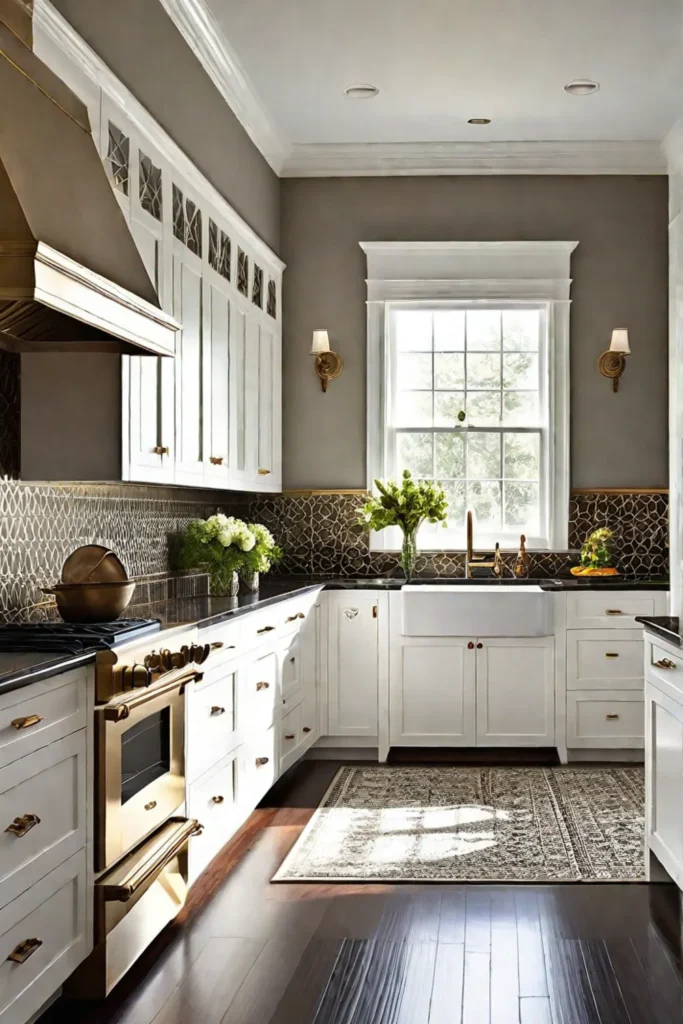
Crown molding is a versatile design element that can elevate the look of any kitchen. With careful consideration of style and proper installation, you can seamlessly incorporate this traditional detail and create a space that exudes warmth, character, and timeless appeal.
The next section focuses on Creating Focal Points with Decorative Backsplashes. In this section, we’ll explore how to add visual interest and personality to your kitchen through eye-catching tile designs.
Creating Focal Points with Decorative Backsplashes
As a designer, I believe that backsplashes are the unsung heroes of the kitchen. Not only do they protect your walls from splatters and spills, but they also offer a canvas for creative expression. With the right backsplash, you can infuse your kitchen with personality and visual interest, creating a stunning focal point that elevates the entire space.
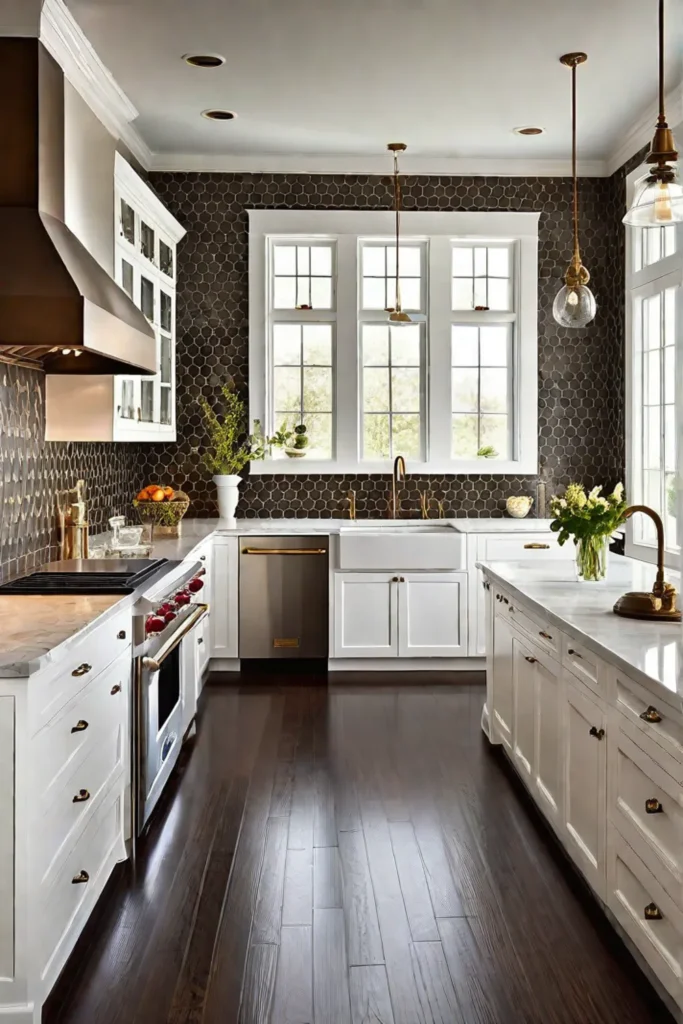
material options
The world of backsplash materials is a treasure trove of possibilities. Each option brings unique charm, from classic subway tiles to sleek glass mosaics. I love natural stone backsplashes—they exude timeless elegance and complement any kitchen style. But if you’re daring, why not explore hand-painted tiles or intricate mosaics? The key is to choose a material that resonates with your design aesthetic and practical needs.
Design Inspiration
When it comes to backsplash designs, the sky’s the limit. Historically, backsplashes were primarily functional and made from simple materials like tile or stone. But today, they’ve become a major design feature, with options ranging from bold patterns to intricate mosaics. My advice? Don’t be afraid to think outside the box. Use patterned tiles to create a statement backsplash behind the stove, or opt for a subway tile backsplash with a contrasting grout color for a timeless look. Consider incorporating a mural or decorative panel into your backsplash design if you’re feeling particularly adventurous.
The key to creating a cohesive look between your backsplash and countertops is to strike a balance. If you choose a bold backsplash, pair it with a more subdued countertop material. Conversely, if your countertops are the show’s star, a subtle backsplash can provide the perfect complementary touch.
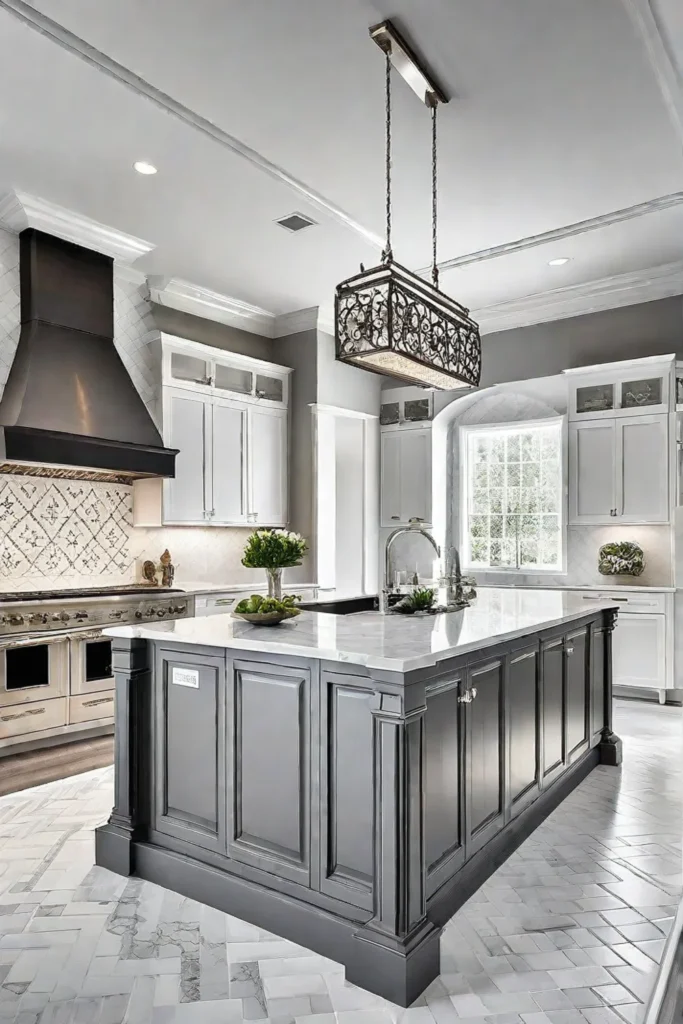
The beauty of decorative backsplashes lies in their ability to transform a functional element into a work of art. You can create a personalized and impactful focal point that reflects your unique style by exploring various materials and designs. So, embrace the possibilities and let your backsplash be the showstopper it deserves to be.
Let’s delve into antique hardware – the perfect finishing touch to your kitchen’s historical charm.
Adding Character with Antique Hardware
As an avid collector of vintage treasures, I can’t resist the allure of antique hardware. These timeless pieces provide a sense of history and authenticity and offer unique, often handcrafted, details that modern reproductions can’t match.
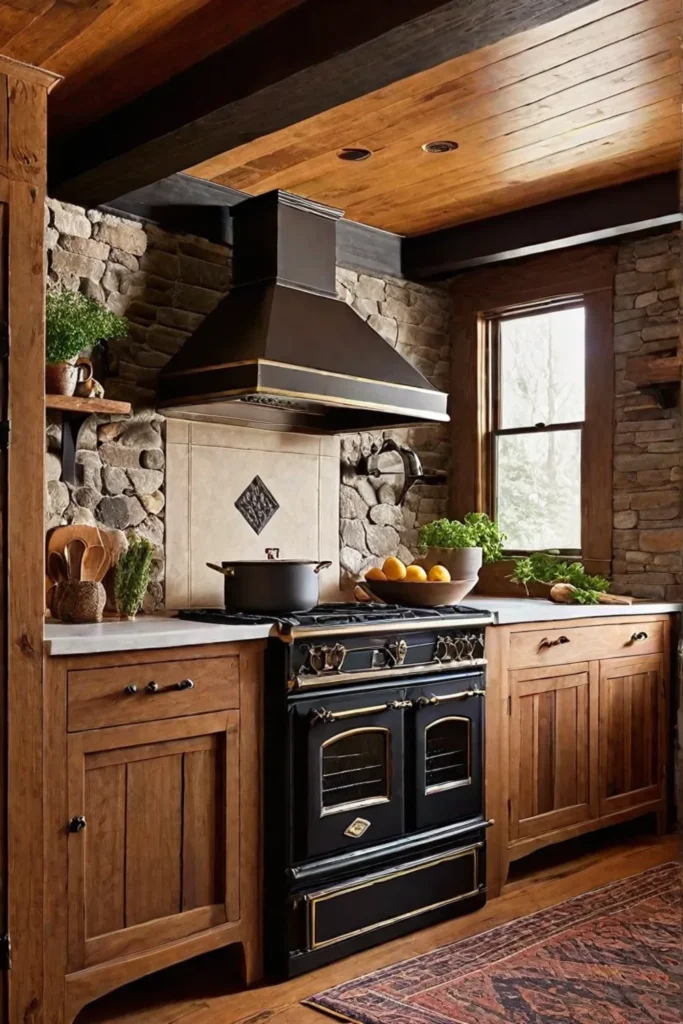
Sourcing Antique Hardware
Hunting for antique hardware is an adventure in itself. My go-to sources are flea markets, antique shops, and online marketplaces specializing in architectural salvage. However, exercising caution and seeking reputable sellers is crucial to ensure you’re getting authentic pieces. Look for telltale signs of age, such as patina, wear patterns, and intricate designs that would be too costly to replicate today.
Restoration and Care Tips
While some antique hardware pieces may require restoration, others possess a charming patina that adds to their character. I recommend gentle cleaning with a soft-bristle brush and a mild soap solution for those needing a little TLC. Avoid harsh chemicals or abrasives that could damage the surface. And remember, a little bit of imperfection makes these pieces truly special.
Incorporating antique hardware into your kitchen design is a surefire way to add a touch of history and personality. Replace standard cabinet knobs with antique glass or ceramic knobs for a vintage touch, or install antique bin pulls on drawers for a rustic farmhouse feel. Antique hinges and latches can also be used on pantry doors or open shelving, creating a cohesive and inviting atmosphere.
One of the most fascinating aspects of antique hardware is the intricate designs and craftsmanship not found in modern pieces. Many of these treasures are made from durable materials like brass, iron, and porcelain, ensuring their longevity for generations. The patina and imperfections only add to their charm and character, telling their own story.
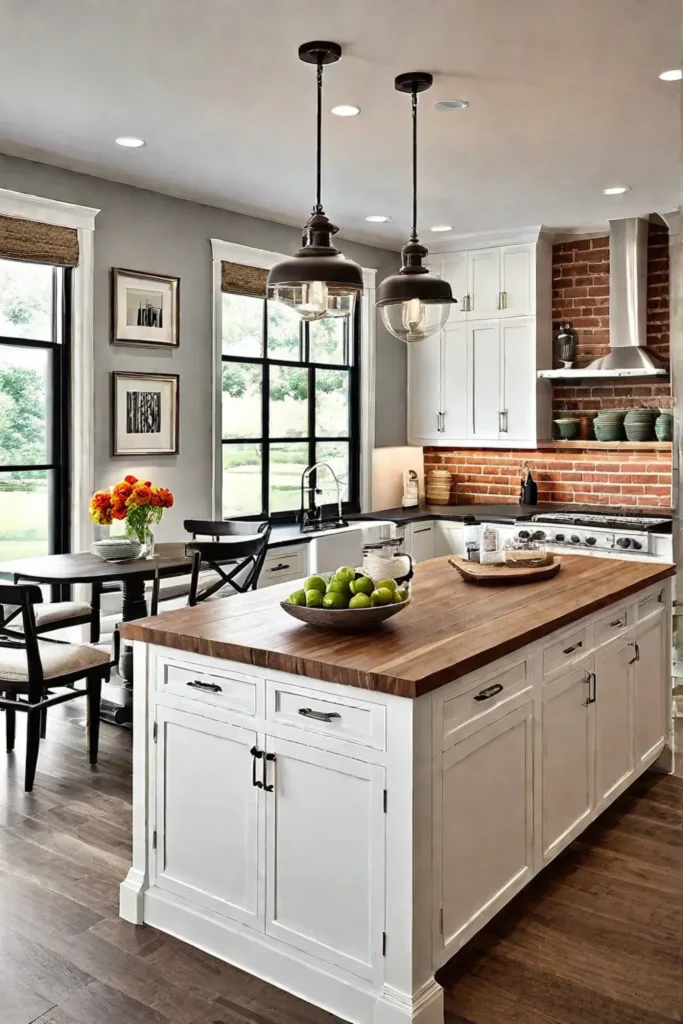
With a keen eye and patience, you can curate a collection of antique hardware that will elevate your kitchen to new heights of character and charm. Remember, these pieces are more than just functional accessories – they’re a tangible link to the past, imbuing your space with a sense of history and authenticity.
Vintage appliances are another way to blend style and functionality in the kitchen, seamlessly transitioning us to the next section.
Vintage Appliances: Blending Style and Functionality
There’s something undeniably charming about vintage appliances, which evoke a sense of nostalgia and classic design. As an expert in home decor, I’m thrilled to share my insights on seamlessly blending these retro beauties into your kitchen while ensuring modern functionality.
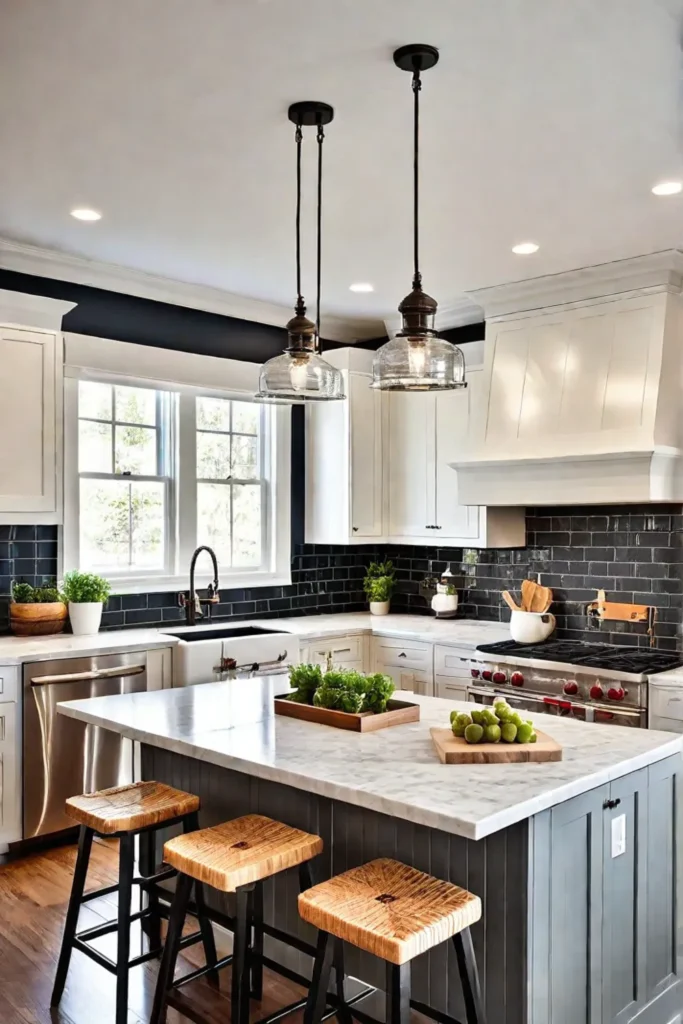
Popular Vintage Appliance Styles
Vintage-style appliances come in various aesthetics, from sleek and streamlined to whimsical and ornate. Retro-inspired designs often feature rounded edges, chrome accents, and vibrant colors like mint green, cherry red, or creamy white. Whether you prefer the mid-century modern look or the charm of an early 20th-century farmhouse, there’s a vintage appliance style to suit your taste.
Integration Tips
Incorporating vintage appliances into your kitchen requires a delicate balance. I recommend choosing a focal point, such as a showstopping vintage-style range or refrigerator, and building the rest of the design around it. Don’t be afraid to mix and match – a vintage-inspired range can beautifully complement modern cabinetry or a sleek countertop. The key is to create a cohesive aesthetic that celebrates the past while embracing the present.
When selecting vintage-style appliances, look for models that combine classic design with modern functionality. Many manufacturers now offer retro-inspired appliances with updated technology, ensuring you get the best of both worlds. For those seeking a truly unique touch, restoring and repurposing genuine vintage appliances can be a sustainable and rewarding design choice.
Consider a retro-inspired refrigerator with rounded edges and chrome accents to integrate vintage-style appliances seamlessly. Opt for a range with classic control knobs and a porcelain enamel finish. And for a traditional touch, a farmhouse sink with an apron front and exposed legs can be a stunning addition.
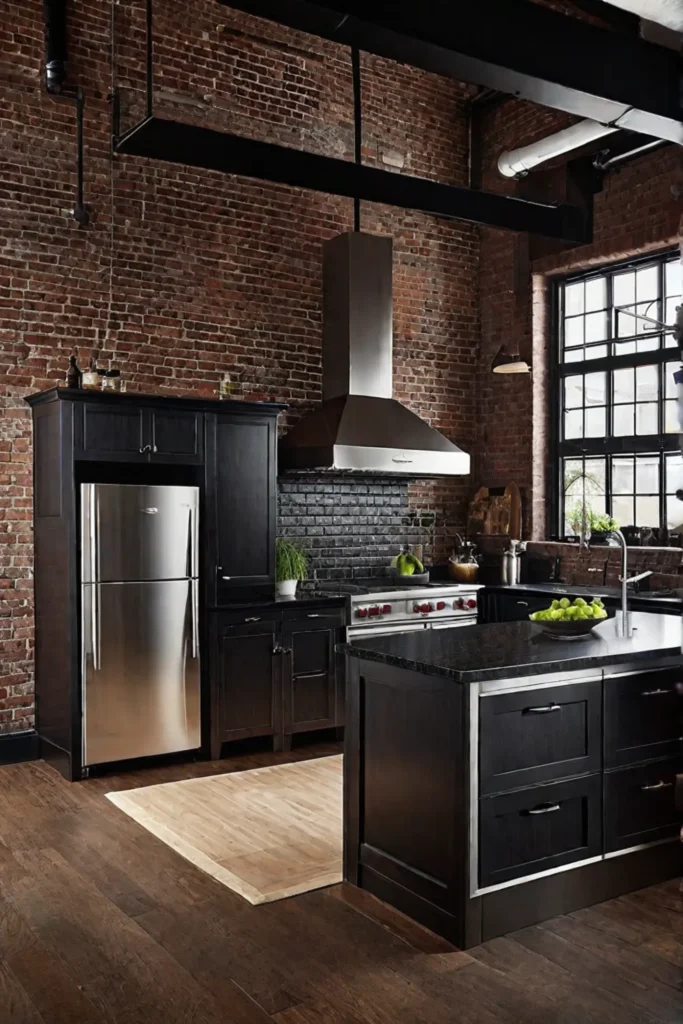
Vintage appliances offer a charming blend of style and functionality, adding a unique character to the kitchen. By selecting appliances that complement the overall design aesthetic, you can create a timeless and inviting space that celebrates the past while embracing modern convenience.
The enduring appeal of farmhouse sinks is a testament to the timeless charm of traditional design elements. Let’s explore how these iconic fixtures can add warmth and character to your kitchen.
The Enduring Appeal of Farmhouse Sinks
I deeply appreciate elements that seamlessly blend functionality and timeless charm. Farmhouse sinks, with their generous basins and classic silhouettes, epitomize this perfect marriage of practicality and style. Let me guide you through the enduring allure of these kitchen workhorses.
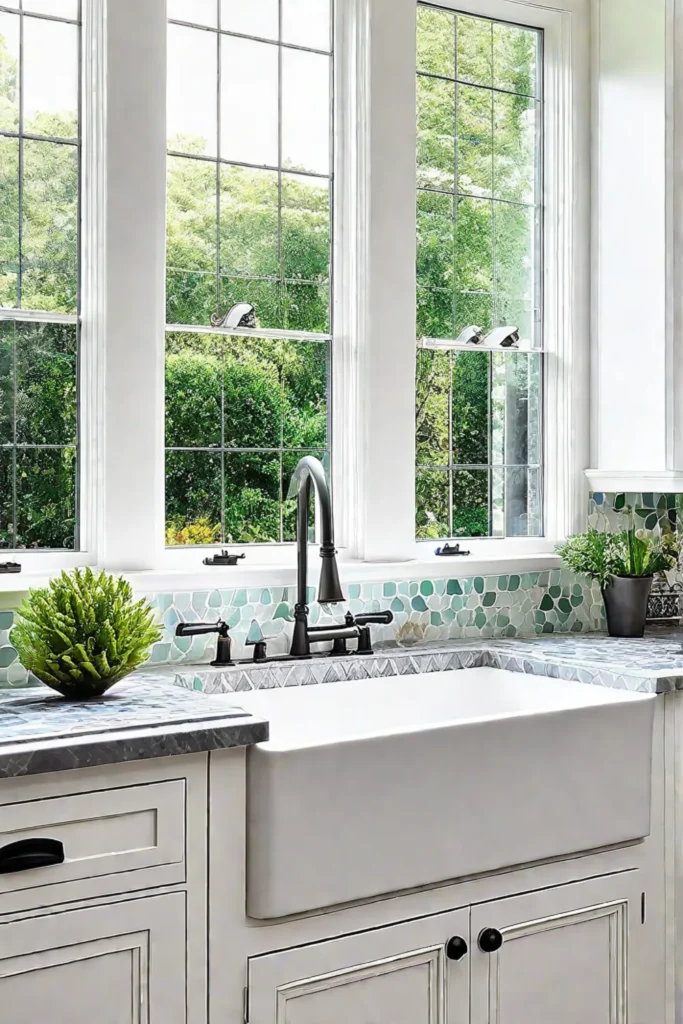
Material Considerations
When it comes to farmhouse sinks, the material you choose is crucial in determining your investment’s aesthetic and durability. Fireclay, a ceramic material fired at high temperatures, offers a classic white finish that complements any kitchen style effortlessly. Copper farmhouse sinks are an excellent choice for those seeking warmth and rustic flair, developing a beautiful patina over time.
Stainless steel and cast iron are also popular options, offering strength and resilience to withstand the demands of a busy kitchen. As someone who values both form and function, I can attest to the importance of carefully considering the material that best suits your needs and design preferences.
Installation Options
Farmhouse sinks are designed to be installed in a way that allows the front apron to extend beyond the cabinetry, creating a distinctive and eye-catching focal point in your kitchen. This installation method adds character and provides ample space for washing large pots and pans or bathing a furry friend (if you’re so inclined!).
For those with existing cabinetry, fear not! Many farmhouse sink models are designed to seamlessly integrate with standard cabinet configurations, ensuring a flawless and cohesive look. Trust me, with the right planning and installation, these sinks can transform your kitchen into a timeless haven of style and efficiency.
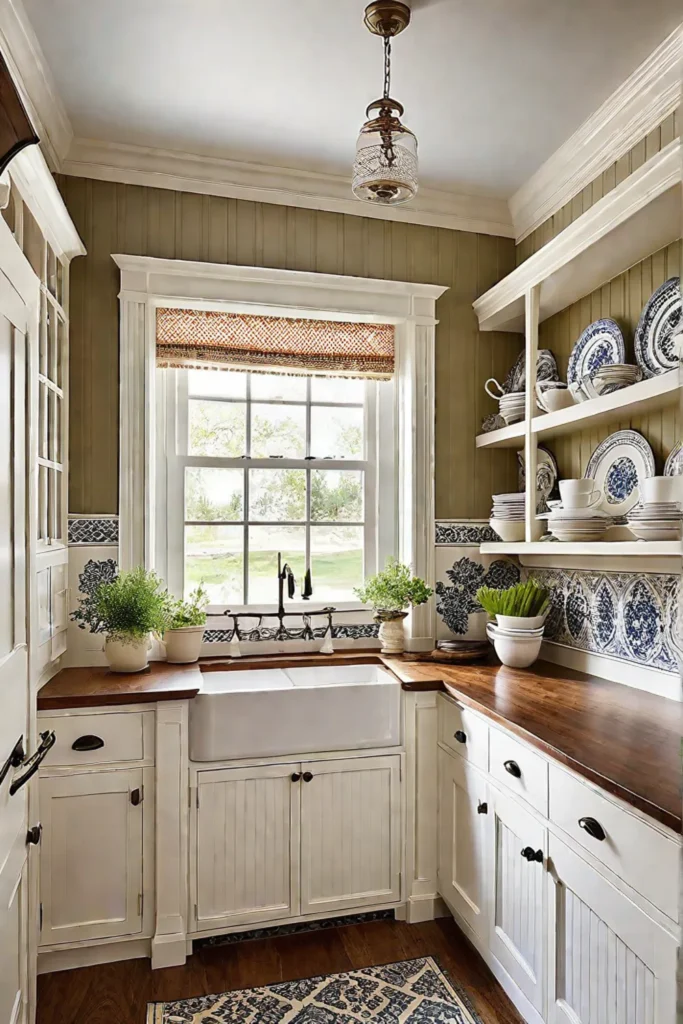
As someone who appreciates farmhouse sinks’ rich history and functionality, I cannot resist sharing a few interesting tidbits. These sinks originated in rural areas with limited access to running water, and their deep basins facilitated efficient dishwashing and laundry tasks. Today, modern farmhouse sinks pay homage to this heritage while offering a range of materials and configurations to suit contemporary lifestyles.
In Closing
As we’ve explored the enduring appeal of traditional kitchen elements, it’s clear that these design choices are more than just superficial embellishments. They are a testament to the enduring power of intentional design, where every detail is carefully considered and curated to create a functional and deeply personal space.
From the architectural elegance of crown molding to the artistry of decorative backsplashes, each element contributes to a narrative that celebrates the rich design history while embracing modern sensibilities. The integration of antique hardware and vintage appliances further enhances this story, infusing the space with a sense of authenticity and character that cannot be replicated.
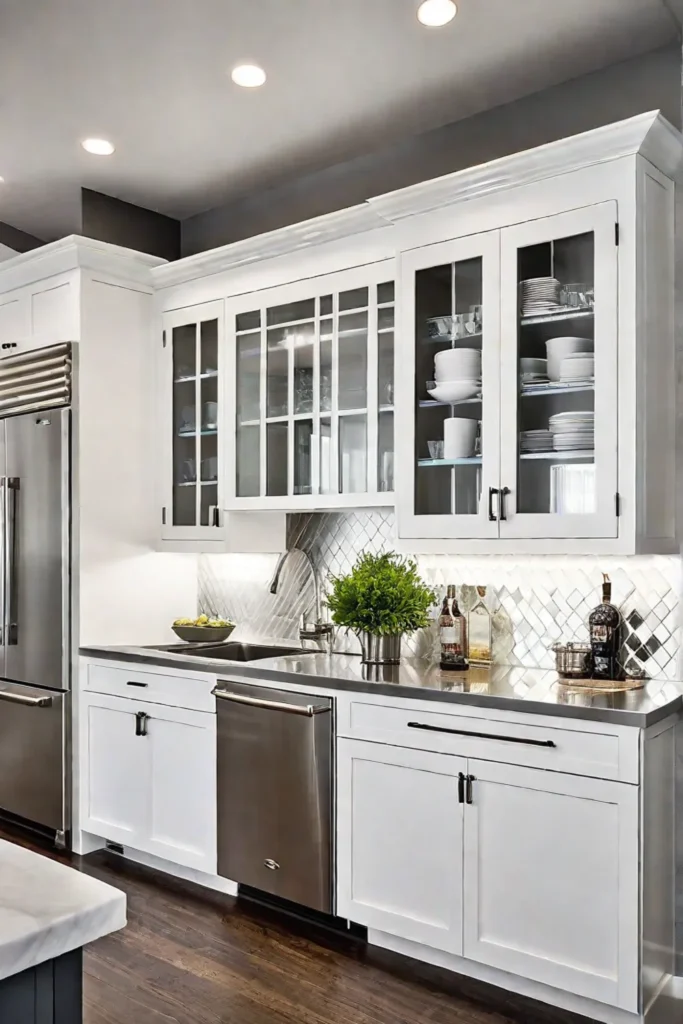
Ultimately, the true beauty of a traditional kitchen lies in its ability to transcend trends and create a timeless sanctuary that feels like a natural extension of your style and values. It’s a space that invites you to slow down, appreciate the craftsmanship and attention to detail that went into its creation, and savor life’s simple pleasures.
So, as you embark on your design journey, remember that the key to creating a truly remarkable kitchen is not merely following trends or adhering to rigid rules but rather embracing the elements that speak to your soul and reflect the unique tapestry of your life. Ultimately, a kitchen is not just a functional space but a canvas upon which you can paint the story of your style and create a lasting legacy for generations to come.
